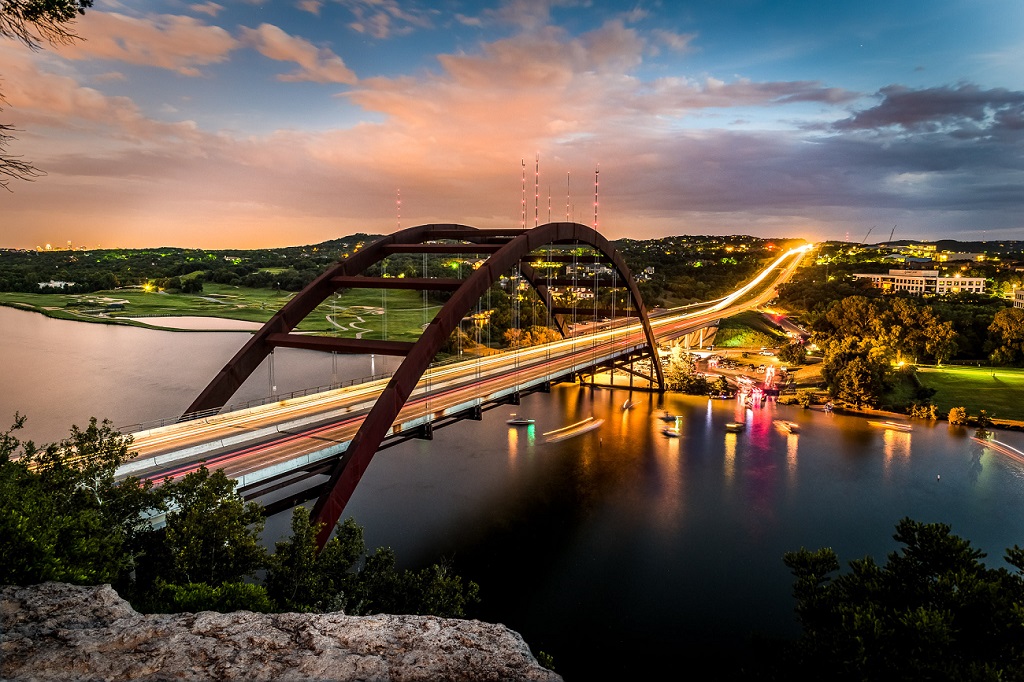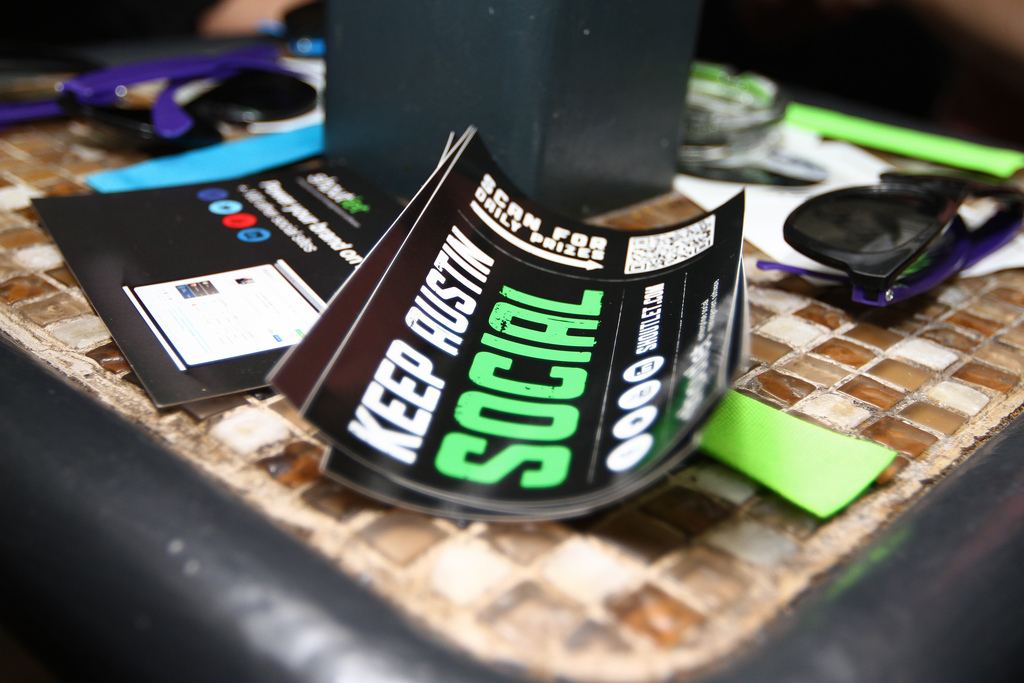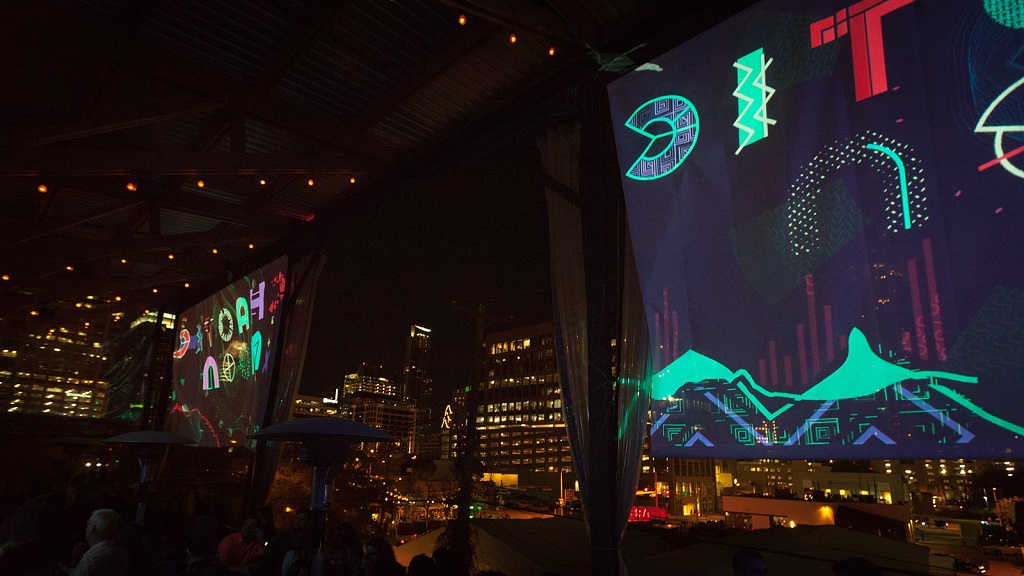https://habr.com/en/company/vsce/blog/444752/- VSCE corporate blog
- History of IT
- Conferences
- Start-up development
- Community management
SXSW is a festival of culture and technology held every spring in Austin, Texas. It’s a global phenomenon, with hundreds of thousands attending the event every year and millions more following the media coverage. Even if you’ve never heard of it, you’ve certainly felt its influence on our culture.
But it wasn’t always that way.
 Austin 360 Bridge | Photo by Brian Dooley | Flickr | CC BY
Austin 360 Bridge | Photo by Brian Dooley | Flickr | CC BY
Counterculture and entrepreneurial spirit
At a quarter of its current population, the 1960s Austin was a quiet college town, home to one of the best
public universities in the country and arguably one of the most liberal places in the South. It was well on its way to complete
desegregation and, as the 70s rolled around, the hippies on the front lines of the civil rights movement gained a foothold in the Austin City Council.
Safe to say, Austin was a city of counterculture, in more ways than one. Small regional banks came to prominence amidst financial deregulation. The old establishment couldn’t compete with the new players and promptly left. Their place was taken by small businesses and tech companies.
IBM,
Texas Instruments and AMD all set up shop in Austin, competing for the brightest UTA graduates. It really was a unique socioeconomic situation.
The city was full of young, talented, ambitious people dying to show what they’re capable of. Anti-war protestors with progressive values held
actual positions of power. Small business was booming. Then, in 1973, Texas
lowered the drinking age to 18, and it all finally came together. Because there’s nothing drunk young adults like more than than live music.
Austin City Limits and the 70s music boom
Austin’s music scene exploded seemingly overnight. Any place large enough to fit a band and a PA system was doing just that. New establishments
opened up all around the city. Some of them are still here today, and those lost to time are all but forgotten. The most influential Austin venue of the 70s was the
Armadillo World Headquarters. It embodied the city’s new homegrown identity, a unique blend of hippy and hillbilly culture called “Redneck Rock”.
This venue
was the voice of Austin.
In 1976, a young television producer Bill Arhos decided to broadcast this voice nation-wide. His creation was none other than the
longest running music show on the American Television — Austin City Limits. For Austinites, it was more than a TV show. It was a cultural institution made to keep the city’s unique voice heard for decades to come.
The unlikely birth of SXSW
However, the economic boom was short-lived. With Austin’s population still on the rise, Texas plunged into a full-blown
banking crisis. The Armadillo World Headquarters closed its doors in 1980. Austin City Limits, despite the popularity, was still being filmed on a shoestring budget.
Reagan’s administration rolled the drinking age back to 21, citing an increase in DUI accidents. The unemployment was terrible. Something had to be done to save the city’s musical heritage and empower entrepreneurs. Two decisions, made as the decade was coming to a close, defined the future of the city.
 Silicon Prairie Party at SXSW | Photo by Silicon Prairie News | Flickr | CC BY
Silicon Prairie Party at SXSW | Photo by Silicon Prairie News | Flickr | CC BY
The first was the creation of the
Austin Technology Incubator. The other was the establishment of SXSW by the team of a
local alternative newspaper.
SXSW Music: the new voice of Austin
The first SXSW was a resounding success. 700 people showed up to watch
177 artists perform at over 15 venues, exceeding the expected attendance by
a lot. Whatever they were selling, people wanted it. And the locals were happy with the attention their city was getting. So the festival kept growing until it became the discovery factory we know today.
John Mayer’s multi-million dollar career took off at SXSW. The White Stripes’
2001 appearance propelled them into mainstream.
James Blunt met the producer of his
best-selling debut album while playing to a half-empty room in 2004. After failing to make it as a Christian signer-songwriter, Katy Perry’s critically acclaimed
2007 SXSW set led to a recording contract that made her the superstar that she is now.
These days, more than 50 thousand people from around the world attend the festival each year, while 2000+ bands perform, hoping to get noticed.
SXSW Interactive: The early days
SXSW was always meant to be more than just another music festival. First and foremost, it was a place for conversation. It was meant to bring creators together and spark cultural fires that would last long after the event itself.
The very first SXSW had some elements of an industry conference. There was a keynote, as well as multiple panel discussions and workshops. At the speed personal computing was developing, it was only a matter of time before digital media became a permanent part of the festival.
The first SXSW Interactive, or, as it was then called, SXSW Film & Multimedia, took place in 1994. That year, the Next Big Thing was … CD-ROM.
People were freaking out about being able to fit music and video on the same disc. The media portion of the conference was
supposed to be secondary, but it outshone the film component and became its own thing the next year.
During the conference’s first four instalments, one of its most popular attractions was the World Wide Web Theatre, which was just a room with several internet connected computers. People lined up for hours to try the Internet for themselves. Todd Rundgren’s 1995 panel ruffled some feathers when he predicted the ubiquity of online media distribution.
All this might sound funny in retrospect, but back then people didn’t quite understand the full potential of this new technology.
 Silicon Prairie Party at SXSW | Photo by Ed Schipul | Flickr | CC BY
Silicon Prairie Party at SXSW | Photo by Ed Schipul | Flickr | CC BY
The potential of the conference itself was also underestimated. Just like the music part of the festival, it kept getting bigger as time went on, cementing its place in the country’s IT landscape after the turn of the century.
Rags to riches: the SXSW Accelerator story
Among the things SXSW helped popularise were: Video streaming (1999), Online blogging (or, as it was called in the year 2000, weblogging), Wearable tech (2001) and Wi-Fi (2003). There was little to no discussion of money and venture capital. If that was your thing, you could go to events in San Francisco or New York. SXSW positioned itself as the idealist’s IT conference. Which proved to be its greatest asset
and its greatest weakness.
A lot of people were digging this new, relaxed, IT conference format. Perhaps, too many. The keynote speakers were getting fancier. The startups were getting bigger. Blogger. Friendster. Twitter. Finally, in 2007, SXSW Interactive became the thing it once despised, and introduced the SXSW Accelerator. The festival outgrew its indie roots. It was time to dominate the industry.
And it did.
Gotta go fast!
SXSW Pitch is an event open for startups from all over the world. Over the course of 11 years, it helped new tech businesses raise more than $5 billion. And while you might not have heard about it, you’ve definitely used at least some of the products that were pitched there.
In February 2010, a group of 24
former Stanford Research Institute employees released a
free iOS app. They worked on it for 2 years with 24 million dollars in funding. It didn’t look ideal. It was too processor-intensive for most iPhone models. They pitched it at SXSW and, just a month later, were acquired by Apple. I’m talking, of course, about
Siri.
Another SXSW success story is that of Kabbage — an online lending platform for businesses. It went on to secure $50M in funding from the Japanese tech giant SoftBank and has gotten big enough to acquire
another fintech startup.
Every year, dozens of startups enter the competition, hoping their story, too, will be that of success.
Sold Out
The creators of SXSW
know they sold out. One of the founders quit back
in 1994, when it was nowhere as big as it is now. Of course, it’s very hard to stay authentic on such a scale. To maintain a semblance of identity when it is formed by more than a hundred thousand people from all over the world. But such success does have its perks.
Their 2016 keynote was delivered by none other than Barack Obama. Buzz Aldrin
held a panel the following year. Elon Musk spoke before a
sold-out crowd in 2018. Not to mention all the tech their Accelerator program helped create. None of it would be possible in the intimate setting of the first SXSW.
Sure, the influx of money and Silicon Valley big wigs may have changed the festival for the worse, but its core philosophy remains tied to the Austin values of the 70s. There’s still a drive to come together, change the world for the better and do it on your terms. Which is certainly something to be celebrated.
About the author:
Dmitry works with brands to create content and promote corporate culture at scale. Apart from it, he is curating Techstars Startup Digest, and acting as an advisor for the SXSW tech festival.
 Techstars Startup Digest: From Launch to Today
Techstars Startup Digest: From Launch to Today
 How the Early Success Stories Shaped the Modern State of the Tech Industry
How the Early Success Stories Shaped the Modern State of the Tech Industry
 Meet A Content Strategist: An Interview with Techstars Curator & SXSW Advisor
Meet A Content Strategist: An Interview with Techstars Curator & SXSW Advisor
 The Game of Archetypes: How Storytelling Works for Tech Brands
The Game of Archetypes: How Storytelling Works for Tech Brands
 How Brands Can Break Through the Tech Media Bubble
How Brands Can Break Through the Tech Media Bubble



Techstars Startup Digest: From Launch to Today
How the Early Success Stories Shaped the Modern State of the Tech Industry
Meet A Content Strategist: An Interview with Techstars Curator & SXSW Advisor
The Game of Archetypes: How Storytelling Works for Tech Brands
How Brands Can Break Through the Tech Media Bubble